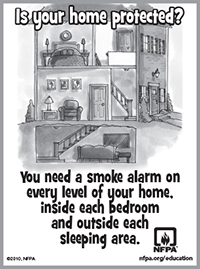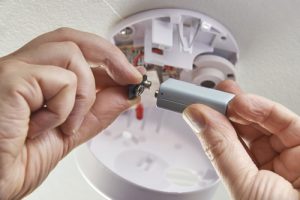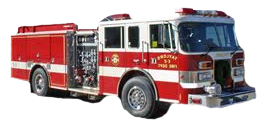Fire Safety – Smoke Alarms
 Smoke alarms
Smoke alarms
Smoke alarms detect and alert people to fire in its early stages, giving them the time needed to escape safely. When working properly, smoke alarms can mean the difference between life and death in a fire.
Smoke alarms must be maintained properly and tested regularly to ensure their effectiveness.
- Smoke alarms should be replaced every 10 years.
- Make sure you know how old all the smoke alarms are in your home.
- To find out how old a smoke alarm is, look at the date of manufacture on the back of the alarm; the alarm should be replaced 10 years from that date.

Safety messages about smoke alarms
- A closed door may slow the spread of smoke, heat, and fire. Install smoke alarms in every sleeping room and outside each separate sleeping area. Install alarms on every level of the home. Install alarms in the basement. Smoke alarms should be interconnected. When one sounds, they all sound.
- Large homes may need extra smoke alarms.
- It is best to use interconnected smoke alarms. When one smoke alarm sounds they all sound.
- Test all smoke alarms at least once a month. Press the test button to be sure the alarm is working.
- Today’s smoke alarms will be more technologically advanced to respond to a multitude of fire conditions, yet mitigate false alarms.
- A smoke alarm should be on the ceiling or high on a wall. Keep smoke alarms away from the kitchen to reduce false alarms. They should be at least 10 feet (3 meters) from the stove.
- People who are hard-of-hearing or deaf can use special alarms. These alarms have strobe lights and bed shakers.
- Replace all smoke alarms when they are 10 years old.
- Smoke alarms are an important part of a home fire escape plan.
Children and smoke alarms
NFPA is aware of research indicating that sleeping children don’t always awake when a smoke alarm activates. While this research is worrisome, we shouldn’t allow them to obscure the fact that smoke alarms are highly effective at reducing fire deaths and injuries.
NFPA reaffirms the value of the smoke alarms already available to protect people from home fire deaths and voice its concern about the number of U.S. households without these early warning devices. While 96% of American homes have at least one smoke alarm, no smoke alarms were present or none operated in two out of five (41%) of the reported home fires between 2003-2006. Almost two-thirds of home fire deaths resulted from fires in homes with no smoke alarms or no working smoke alarms.
NFPA emphasizes the need to continue planning and practicing home fire escape plans and to make sure everyone in a home can be awakened by the sound of the smoke alarm. NFPA suggests practicing the escape plan during which the smoke alarm is activated so all family members know its sound.
Every home fire escape plan is different, and every family should know who will – and who won’t – awaken at the sound of the smoke alarm. If someone doesn’t wake up when the alarm sounds during a drill, the family should design an escape plan that assigns a grown-up who is easily awakened by the alarm to wake the sleepers, perhaps by yelling “FIRE,” pounding on the wall or door, or blowing a whistle.
Smoke Alarms English | Smoke Alarms Spanish
Smoke Alarms for people who are deaf or hard-of-hearing
Home Smoke Alarm Statistics
Resources:
https://www.nfpa.org




